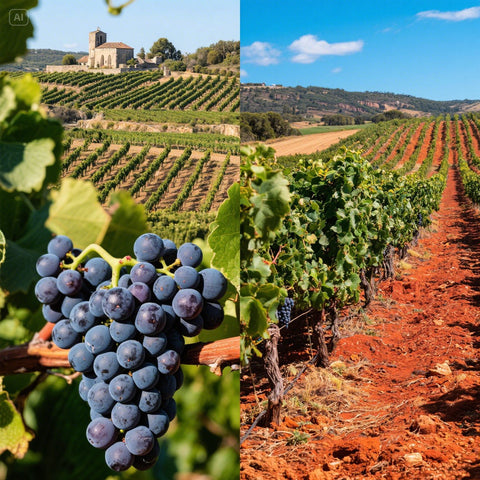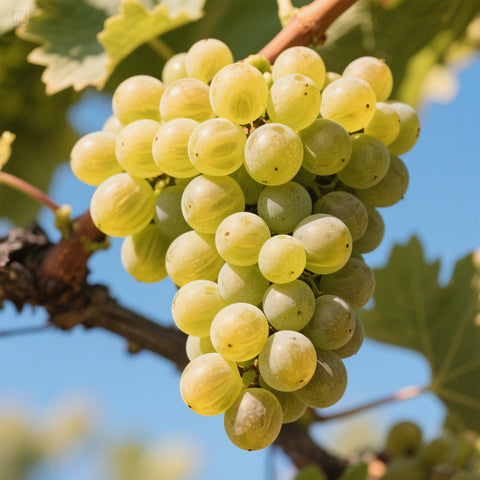The Origins of the Merlot Wine Grape: From Bordeaux Charm to Global Appeal
Merlot stands as one of the world's most beloved and widely planted wine grapes, celebrated for its approachable character, velvety texture, and remarkable versatility. From its historic role in the legendary wines of Bordeaux's Right Bank to its modern expressions in regions as diverse as California's Napa Valley and Australia's McLaren Vale, Merlot has captured the hearts of wine lovers with its combination of elegance and accessibility.
Yet behind this popular variety lies a fascinating origin story that intertwines ancient cultivation, noble parentage, and centuries of careful development that have shaped Merlot into the distinguished grape we know today.
The Bordeaux Origins of Merlot
Merlot's story begins in the vineyards of Bordeaux, where it has been cultivated since at least the 14th century. The earliest documented mention comes from the Libournais region on the Right Bank, where Merlot was already valued for its exceptional quality. Its name likely derives from merle, the French word for blackbird—either due to the grape’s deep blue-black hue or the bird’s fondness for its ripe berries.
By the 15th century, Merlot had become a dominant variety in Saint-Émilion and Pomerol. Its ability to ripen early and reliably made it a favourite among growers in Bordeaux’s variable climate, especially in the limestone and clay soils of the Right Bank.
The Genetic Revelation
Modern DNA analysis has since confirmed Merlot’s noble lineage: a natural cross between Cabernet Franc and the now-rare Magdeleine Noire des Charentes. From Cabernet Franc, it inherited structure and aging potential; from Magdeleine Noire, its softness, early ripening, and easy charm. This parentage also makes Merlot a half-sibling to Cabernet Sauvignon, explaining their blending synergy and shared success in premium wine regions.
The name Merlot offers insight into both the grape’s character and its early reputation. Most wine historians agree that it derives from the French word merle, meaning blackbird, either because of the grape’s deep blue-black colour, which resembles the bird’s plumage, or because blackbirds were particularly fond of eating the ripe berries.
This etymology is fitting for a variety known for its distinctive appearance and broad appeal. Interestingly, Merlot hasn’t always gone by this name. Historically, it was also referred to as Merlau, Plant Médoc, Sémillon Rouge, Béguey, Picard, Alicante, and Crabutet Noir, names that reflect its long-standing cultivation and evolving identity across Bordeaux.
Today, Merlot is the most widely planted grape in Bordeaux, prized for its supple, round structure and its rich aromas of plum, fig, and red fruits, often developing roasted or savoury notes with age. Its full potential is best expressed in cool, moist soils, particularly on the clay-rich Right Bank.
The Global Rise of Merlot
Merlot’s worldwide success can be attributed to a unique combination of viticultural and winemaking advantages that appeal to both growers and consumers. It ripens earlier than Cabernet Sauvignon, making it more reliable in marginal climates, and offers naturally higher yields and solid disease resistance, an economic win for producers.
In the winery, Merlot is remarkably versatile. Depending on region and technique, it can produce anything from light, fruity reds to full-bodied, cellar-worthy wines. Its soft tannins and rich fruit character make it approachable for casual drinkers while offering enough complexity for collectors. It’s also prized for its ability to clearly express terroir, like a chameleon, it adapts to various soils and climates while maintaining its essential identity.
These qualities helped fuel Merlot’s expansion beyond Bordeaux throughout the 19th and 20th centuries. In Italy, it thrived in the Veneto and Friuli regions, where winemakers crafted fruit-forward yet structured styles. In the New World, regions like California, Washington State, Chile, and South Africa embraced Merlot’s potential, producing wines that range from plush and generous to refined and elegant.
Each region has shaped its own expression of Merlot, reinforcing the grape’s reputation as one of the most adaptable and internationally respected red wine varieties.
Merlot in Australia
Australia’s relationship with Merlot began in earnest during the 1960s and 1970s, later than many other international varieties. Early efforts were met with uncertainty, as the grape’s reputation for thriving in Bordeaux’s moderate climate seemed at odds with Australia’s generally warm, dry conditions. Many early plantings were established in regions that proved too hot, producing wines that, while fruity and approachable, often lacked acidity, structure, and sophistication.
Throughout the 1970s and 1980s, Australian Merlot frequently drew criticism for being overly jammy or one-dimensional. But with time came a better understanding of how to work with the variety. The turning point arrived when producers began matching Merlot to more suitable sites, paying close attention to elevation, aspect, and soil type to find cooler microclimates better suited to the grape.
Alongside improved site selection, the adoption of precision viticulture techniques transformed Australian Merlot. Controlled irrigation, advanced canopy management, and strategic harvest timing helped producers retain acidity, build structure, and enhance flavour development. These innovations have not only lifted the quality of Australian Merlot but have also influenced warm-climate Merlot production globally.
McLaren Vale’s Merlot Journey
While regions like the Yarra Valley and Margaret River first gained attention for cool-climate Merlot, it’s McLaren Vale that has redefined what’s possible for the variety in Australia. Once overlooked due to its warm Mediterranean climate, McLaren Vale has become a standout example of how site-specific viticulture can unlock exceptional Merlot in unexpected places.
Early scepticism was understandable, Merlot was thought to prefer cooler conditions, and the region was dominated by Shiraz and Grenache. But a few forward-thinking winemakers began experimenting with Merlot in elevated vineyards, shaded aspects, and blocks near the cooling influence of Gulf St Vincent. These microclimates offered a new canvas for the variety.
The results challenged assumptions. Far from being jammy or flat, McLaren Vale Merlot proved rich, structured, and refined. Through precision viticulture, including canopy management, targeted irrigation, and careful harvest timing, producers created Merlots that retained freshness, depth, and varietal character.
While other regions still produce noteworthy examples, McLaren Vale has carved out a niche as the leading warm-climate home for Merlot in Australia. The wines balance approachability with complexity, offering bold fruit flavours underpinned by natural acidity and soft tannins. It’s a regional success story that continues to evolve, and impress.
Unlocking the Terroir of McLaren Vale
The success of McLaren Vale Merlot lies in smart site selection and climate-savvy viticulture. McLaren Vale’s rolling hills offer varied elevations, especially above 200 metres, creating cooler microclimates ideal for growing Merlot with freshness and complexity. These cooler nights and longer ripening periods allow grapes to develop structure and depth without losing natural acidity.
Soil variation is another advantage. Clay-rich blocks help retain water in dry summers, preventing overripeness, while the region’s iconic red ironstone encourages deep roots and concentrated fruit. Coastal vineyards also benefit from the cooling breezes off Gulf St Vincent, which help moderate heat during ripening.
Growers in the region have embraced tailored techniques to get the best from the climate. Canopy management is precise, with carefully timed leaf removal to balance sun exposure and acidity. Precision irrigation helps manage water stress and promote flavour development. Many producers also harvest Merlot early in the morning, or even at night, to lock in freshness, with some using refrigeration to chill fruit immediately post-pick.
This thoughtful approach has positioned McLaren Vale as a leader in warm-climate Merlot, crafting wines that are bold yet refined, and unmistakably true to place.
The Modern McLaren Vale Merlot Style
Today’s McLaren Vale Merlot delivers a confident, site-driven expression that pairs the grape’s natural softness with structure and depth. Far from the overripe styles once feared in warm climates, the best examples showcase rich flavours of dark plum, blackberry, and black cherry, layered with hints of chocolate and subtle spice from well-integrated oak.
Thanks to the region’s coastal influence, these wines retain natural acidity, balancing ripeness with freshness. This maritime cooling tempers heat during the growing season and contributes to a vibrant, lively mouthfeel, even in fuller-bodied examples.
While varietal Merlots from McLaren Vale are increasingly celebrated, many winemakers also blend with compatible Bordeaux varieties like Cabernet Sauvignon or Petit Verdot to enhance structure and complexity. These blends offer a nod to tradition while reflecting the power and generosity of the local terroir.
Tannins in McLaren Vale Merlot tend to be plush and rounded, making the wines approachable in youth, yet the best expressions carry enough backbone to age gracefully. With time, they evolve into savoury, textural wines with notes of dried herbs, earth, and leather, proof of their versatility and craftsmanship.
Future Prospects for McLaren Vale Merlot
Climate change is reshaping wine regions worldwide, and McLaren Vale is already ahead of the curve. Having mastered Merlot in a warm Mediterranean climate, the region is uniquely positioned to adapt. As global temperatures rise, some cool-climate areas may struggle with ripening, while parts of McLaren Vale may become even more suitable for premium Merlot production.
Producers here have decades of experience fine-tuning Merlot for local conditions, through elevation-specific planting, water management, and microclimate selection. These adaptive strategies are now becoming a model for other warm-climate regions tackling similar climate pressures. Precision viticulture, early-morning harvesting, and canopy control are no longer just tools for quality, they’re essential techniques for climate resilience.
The region’s efforts are paying off. McLaren Vale Merlot is earning critical acclaim and winning over consumers with its depth, elegance, and drinkability. As wine preferences shift toward approachable yet structured reds, the style emerging from McLaren Vale hits the mark, ripe yet balanced, expressive yet versatile.
This success reflects more than just a well-suited grape. It’s a case study in how innovation, terroir knowledge, and long-term commitment can shape a region’s future. McLaren Vale’s Merlot evolution continues to inspire, proving that warm-climate winemaking can be both sustainable and exceptional.
Conclusion
Merlot’s journey, from its Bordeaux roots to thriving in regions like McLaren Vale, shows how tradition and innovation can coexist. McLaren Vale’s rise as a Merlot producer reflects the power of terroir, smart site selection, and modern viticulture to transform a once-overlooked variety into a regional strength.
As global wine tastes evolve, Merlot’s adaptability and the region’s commitment to quality continue to set the standard. Explore our McLaren Vale Merlot range and experience the results of this ongoing evolution.




Comments (0)
There are no comments for this article. Be the first one to leave a message!